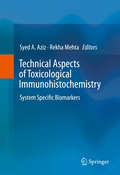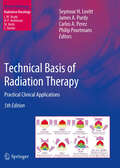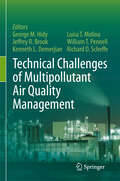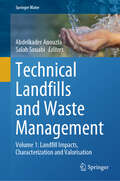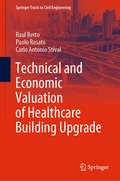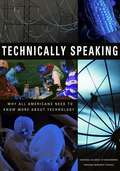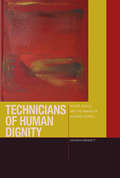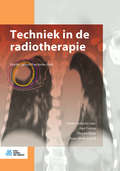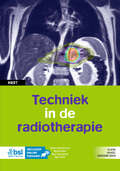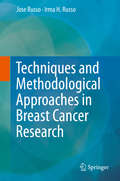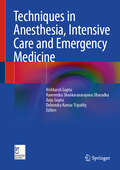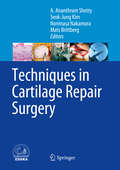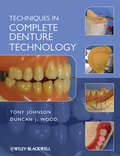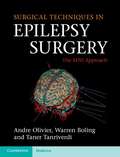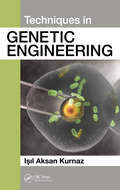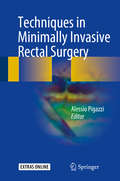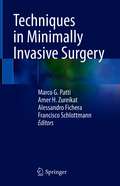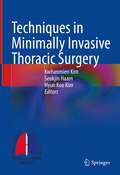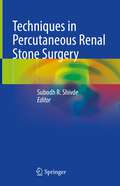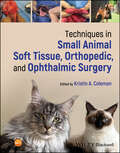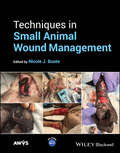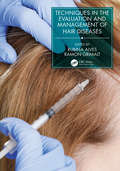- Table View
- List View
Technical Aspects of Toxicological Immunohistochemistry
by Syed A. Aziz Rekha MehtaThis authoritative volume examines immunohistochemical methods aimed at investigating the toxicologic pathology of rodent, non-human primate and aquatic animal tissues. Eleven comprehensive chapters provide pathologists and researchers in various sub-disciplines of toxicology with a comprehensive review of the methods and approaches for immunohistochemical staining in various target tissues. It explores the tissue-antigen and antibody-specific problems that may be encountered during the staining procedures and provide potential avenues for resolving various methodological issues. Special attention is paid to the latest enhancement procedures for antigen retrieval and visualization as well as image analysis and antigen quantification. Written by leading researchers in toxicology and pathology, this book is a significant resource for toxicologists and pathologists working with rodents, monkeys and aquatic animal tissues.
Technical Basis of Radiation Therapy
by Carlos A. Perez James A. Purdy Philip Poortmans Seymour H. LevittThis well-received book, now in its fifth edition, is unique in providing a detailed examination of the technological basis of radiation therapy. Another unique feature is that the chapters are jointly written by North American and European authors. This considerably broadens the book's contents and increases its applicability in daily practice throughout the world. The book is divided into two sections. The first section covers basic concepts in treatment planning and explains the various approaches to radiation therapy, such as intensity-modulated radiation therapy, tomotherapy, stereotactic radiotherapy, and high and low dose rate brachytherapy. The second discusses in depth the practical clinical applications of the different radiation therapy techniques in a wide range of cancer sites. All chapters have been written by leaders in the field. This book will serve to instruct and acquaint teachers, students, and practitioners with the basic technological factors and approaches in radiation therapy.
Technical Biochemistry: The Biochemistry and Industrial Use of Natural Products
by Oliver Kayser Nils J. AvereschThis textbook of biochemistry has been completely revised and expanded for its second edition. Biotechnologists and bioprocess engineers will find precise information on modern issues in the fascinating and complex field of technical biochemistry, where technology and biology need not be a contradiction. The authors have attempted to write a textbook for students of bioengineering from the students' perspective. Unlike well-known and well-established textbooks in biology, biochemistry, and biotechnology, this book presents biological concepts and links them with technical and engineering problems. The aim of this textbook is to shed light on biochemical principles in natural product biosynthesis and explain their biotechnological and bioprocess engineering production pathways. Content: Application of biochemistry in medicine, pharmacy, and engineering Photosynthesis – The chemistry of light Carbohydrate metabolism – Sugars as energy carriers Amino acids and peptides – Proteins as biocatalysts Carbohydrates, lipids, and proteins – Building blocks for technical and pharmaceutical substances Important biosyntheses of primary and secondary metabolism Natural product biosynthesis – Biology and chemistry of secondary metabolites Target Audience: Students of bioprocess engineering, biotechnology, pharmacy, chemistry Biologists, biotechnologists, process engineers, pharmacists, chemists with a focus on biotechnology
Technical Challenges of Multipollutant Air Quality Management
by Luisa T. Molina Jeffrey R. Brook Kenneth L. Demerjian Richard D. Scheffe George M. Hidy William T. PennellRecent critiques of air quality management approaches currently employed in developed and many developing countries have suggested that efficiencies could be achieved if air quality management practices shifted from pollutant-by-pollutant approaches to a comprehensive multipollutant approach in which emission reduction decisions are based on relative risk and evaluated on their effectiveness in meeting environmental and health goals. This book assesses our technical readiness to undertake such an approach, and it outlines the technical developments that will be needed to achieve a risk-based approach air quality management that includes means for measuring the effectiveness of management decisions.
Technical Landfills and Waste Management: Volume 1: Landfill Impacts, Characterization and Valorisation (Springer Water)
by Salah Souabi Abdelkader AnouzlaA "zero waste" society and the "circular economy" trend are urgently needed. Even if achieving 100% trash recycling and a fully circular economy may not always be attainable, aiming toward this goal might result in a sustainable future. Municipal solid wastes pose a hazard to the environment because of open burning, landfills, reckless disposal, and many other factors. Waste is being thrown away in more significant quantities and is made up of several different materials. Municipal solid waste (MSW) characteristics must be carefully considered when developing, implementing, or modifying solid waste management systems. Local waste variables that vary with cultural, climatic, socioeconomic, and institutional capacities are crucial for developing efficient waste management techniques. This book provides a comprehensive overview of landfills' situation, their categories, and the types of garbage they receive. The final section of the study provides an overview of prospective waste management techniques, their restrictions, and the potential areas for further research on landfill sites. This book has the advantage that world-class experts in their respective fields have written each chapter. As a result, this book presents a balanced picture across the whole spectrum of chapters on municipal solid wastes.
Technical Landfills and Waste Management: Volume 2: Municipal Solid Waste Management (Springer Water)
by Salah Souabi Abdelkader AnouzlaThis book examines the issue of solid waste generation and management as a worldwide phenomenon, focusing on strategies that facilitate the disposal and utilization of waste while ensuring environmental integrity and meeting the needs of future generations. The process of urbanization, particularly in densely populated cities, has resulted in a notable increase in the production of solid waste. Unfortunately, the current management system employed by the government, as well as the available resources and technical capabilities, is insufficient in effectively addressing this issue. As a result, the accumulation of solid waste in the environment continues to rise, causing adverse impacts on both the natural surroundings and human well-being. The contamination of the air, soil, and water directly stems from this mounting waste. To confront this global challenge, determined efforts are being made to manage and diminish the volume of solid waste, with the ultimate goal of safeguarding the environment and preserving the welfare of future generations. Furthermore, the book delves into various sustainable development approaches, such as Gasification and Ash Melting, Anaerobic Digestion, and Composition. Additionally, it highlights the recent advancements in these techniques by scientists, which contribute to promoting sustainable solid waste management.
Technical and Economic Valuation of Healthcare Building Upgrade (Springer Tracts in Civil Engineering)
by Paolo Rosato Raul Berto Carlo Antonio StivalThe book presents a methodology for detecting intervention needs on existing healthcare buildings and estimating the related costs, to perform a sustainable financial planning for modernization, regulatory adjustment and performance upgrade. By the identification of specific parameters, characterizing the building in terms of layout typology, technical features and services provision, it proposes a framework for the collection of relevant information to current regulations and standards. Integrated evaluation tools are developed to perform first a technical assessment of the investigated building, basing on the survey of its key features and on the codification of standard actions. Then, appraisal procedure valuates intervention cost from the similarity degree between the object of analysis and a set of interventions already performed on healthcare assets. The book offers a valuable tool for technical professionals, public administrations and healthcare managers engaged in maintenance and performance assessment of healthcare facilities.
Technically Speaking: Why All Americans Need To Know More About Technology
by Committee on Technological LiteracyCell phones ... airbags ... genetically modified food ... the Internet. These are all emblems of modern life. You might ask what we would do without them. But an even more interesting question might be what would we do if we had to actually explain how they worked? The United States is riding a whirlwind of technological change. To be sure, there have been periods, such as the late 1800s, when new inventions appeared in society at a comparable rate. But the pace of change today, and its social, economic, and other impacts, are as significant and far reaching as at any other time in history. And it seems that the faster we embrace new technologies, the less we’re able to understand them. What is the long-term effect of this galloping technological revolution? In today’s new world, it is nothing less than a matter of responsible citizenship to grasp the nature and implications of technology. Technically Speaking provides a blueprint for bringing us all up to speed on the role of technology in our society, including understanding such distinctions as technology versus science and technological literacy versus technical competence. It clearly and decisively explains what it means to be a technologically-literate citizen. The book goes on to explore the context of technological literacy—the social, historical, political, and educational environments. This readable overview highlights specific issues of concern: the state of technological studies in K-12 schools, the reach of the Internet into our homes and lives, and the crucial role of technology in today’s economy and workforce. Three case studies of current issues—car airbags, genetically modified foods, and the California energy crisis—illustrate why ordinary citizens need to understand technology to make responsible decisions. This fascinating book from the National Academy of Engineering is enjoyable to read and filled with contemporary examples. It will be important to anyone interested in understanding how the world around them works.
Technicians of Human Dignity: Bodies, Souls, and the Making of Intrinsic Worth (Just Ideas)
by Gaymon BennettTechnicians of Human Dignity traces the extraordinary rise of human dignity as a defining concern of religious, political, and bioethical institutions over the last half century and offers original insight into how human dignity has become threatened by its own success. The global expansion of dignitarian politics has left dignity without a stable set of meanings or referents, unsettling contemporary economies of life and power.Engaging anthropology, theology, and bioethics, Bennett grapples with contemporary efforts to mobilize human dignity as a counter-response to the biopolitics of the human body, and the breakdowns this has generated. To do this, he investigates how actors in pivotal institutions —the Vatican, the United Nations, U.S. Federal Bioethics—reconceived human dignity as the bearer of intrinsic worth, only to become frustrated by the Sisyphean struggle of turning its conceptions into practice.
Techniek in de radiotherapie (Medische beeldvorming en radiotherapie)
by Hans Welleweerd Age Froma Mirjam MastDit boek beschrijft alle fysische en technische aspecten van een radiotherapiebehandelplan. Hierbij wordt de route gevolgd die de patiënt aflegt over de afdeling radiotherapie. De verschillende hoofdstukken zijn geschreven door klinisch fysici, MBB’ers, klinisch fysisch medewerkers en anderen die nauw bij het vakgebied betrokken zijn.Techniek in de radiotherapie maakt deel uit van de serie Medische beeldvorming en radiotherapie. In deze vernieuwde uitgave zijn diverse innovaties toegevoegd, zoals de MR-Linac en protonenbestralingen. Verder zijn de fysisch/technische aspecten vernieuwd en zijn verouderde technieken uit het boek verdwenen. De redactie streeft ernaar aan te sluiten bij de hedendaagse standaard van de radiotherapie. Aangezien radiotherapie een technisch gedreven vakgebied is, zullen de ontwikkelingen snel gaan. De redactie zal in samenwerking met de auteurs het boek met gepaste frequentie actueel houden.Techniek in de radiotherapie is behalve als leerboek voor MBB'ers (medisch beeldvormend en bestralingsdeskundigen) ook als naslagwerk bij uitstek geschikt voor hen die reeds de (initiële) opleiding hebben afgesloten. Daarnaast is de uitgave een goede introductie voor radiotherapeuten, klinisch fysici en klinisch fysisch medewerkers, al dan niet in opleiding, en anderen die nauw betrokken zijn bij de afdeling radiotherapie.
Techniek in de radiotherapie (Medische beeldvorming en radiotherapie)
by Age Froma Mirjam Mast Paul Van HaarenDit boek beschrijft alle fysische en technische aspecten van een radiotherapiebehandelplan. Hierbij wordt de route gevolgd die de patiënt aflegt over de afdeling radiotherapie. De verschillende hoofdstukken zijn geschreven door klinisch fysici, MBB&’ers (medisch beeldvormend en bestralingsdeskundigen), klinisch fysisch medewerkers en anderen die nauw bij het vakgebied betrokken zijn. In deze herziene editie van Techniek in de radiotherapie is een update uitgevoerd van de verschillende beschreven innovaties. Daarnaast is de online adaptieve werkroute uitgebreider beschreven en is de ringbased versneller toegevoegd. Verder zijn de fysisch-technische aspecten geactualiseerd en zijn verouderde technieken uit het boek gehaald. Aangezien radiotherapie een techniekgedreven vakgebied is, gaan de ontwikkelingen snel. De redactie zal in samenwerking met de auteurs het boek met gepaste frequentie actueel houden. De website bij dit boek maakt het mogelijk om altijd en overal te studeren en informatie op te zoeken. Techniek in de radiotherapie maakt deel uit van de serie Medische beeldvorming en radiotherapie. Het is behalve als leerboek voor MBB'ers ook bij uitstek geschikt als naslagwerk voor hen die reeds de (initiële) opleiding hebben afgesloten. Daarnaast is de uitgave een goede introductie voor radiotherapeut-oncologen, klinisch fysici en klinisch fysisch medewerkers, al dan niet in opleiding, en anderen die nauw betrokken zijn bij de afdeling radiotherapie.
Techniques and Methodological Approaches in Breast Cancer Research
by Jose Russo Irma H. RussoThis volume explores the myriad of techniques and methodological approaches that are being used in breast cancer research. The authors critically evaluate of the advantages and disadvantages of current methodologies, starting with the tools available for understanding the architecture of the human breast, including its tissue and cellular composition The volume discusses the importance of functional studies in breast cancer research, especially with the help of laser capture microdissection, which allows the separation of small amounts of tissue, as well as specific cells, for biochemical analysis. In addition, the authors address methodologies including stem cell separation, which has helped in significantly understanding their role in normal breast development, but also further the understanding of breast cancer and its therapeutic management. The use of in vitro techniques and established cell lines for mechanistic studies in chemotherapeutic approaches have been invaluable will be discussed Imaging techniques for evaluating in vitro and in vivo behavior of normal and cancerous breast tissue will be explored, as it provides a better understanding of the physiopathology of cancer. The volume will also discuss the molecular analysis of gene function in breast cancer through the transcriptomic and epigenomic profile. More importantly, the advancement of more refined techniques in sequencing will be covered This monograph will be a comprehensive, authoritative and timely, as it addresses the emerging approaches used in breast cancer research.
Techniques for Assessment of Parkinsonism for Diagnosis and Rehabilitation (Series in BioEngineering)
by Sridhar P. Arjunan Dinesh Kant KumarThis book describes the range of technologies that have been developed for diagnosing and assessing Parkinson’s disease patients. Also presenting the latest studies providing insights into the changes to the neural system in Parkinson’s disease, it is a valuable resource for neurologists, general practitioners and nurses. Further, the book highlights areas that require more research, and as such will appeal to researchers, biomedical engineers and clinicians.
Techniques in Anesthesia, Intensive Care and Emergency Medicine
by Nishkarsh Gupta Raveendra Shankaranarayana Ubaradka Debendra Kumar Tripathy Anju GuptaThe book covers a wide range of techniques useful for medical and paramedical professionals across specialties such as anesthesiologists, intensivists, and emergency physicians. It includes techniques and procedures ranging from the simple ones like intravenous access to the advanced ones like transesophageal echo (TEE) or extracorporeal membrane oxygenators (ECMO). It covers the basic techniques in detail helping the clinicians as well as the paramedical staff like nursing, anesthesia assistants and emergency technicians in developing their knowledge and skills in management of emergency and critical situations. Additionally, the book explains the fundamentals of advanced techniques like TEE and ECMO to prepare the readers for an advanced learning and training subsequently. Each technique is presented in a simple, lucid and practical way with complete details of the steps, equipment, indications, and contraindications. It also emphasizes modifications for different settings, like emergency and critical care settings, wherever appropriate. The book is an up-to-date and evidence-based resource contributed by expert professionals.
Techniques in Cartilage Repair Surgery
by Norimasa Nakamura A. Ananthram Shetty Seok-Jung Kim Mats BrittbergCartilage defects are common. Cartilage repair surgery is not only fascinating but also surgically challenging. There are books dealing with basic science and some surgical aspect. This book fills a gap in surgical techniques for cartilage repair. All of the surgical chapters are logically organised, covering patient selection, patient setup/positioning, surgical approach, potential complications and troubleshooting. An attempt is made to compare with various surgical techniques. This book also covers anaesthesia, postoperative follow-up, pain management and rehabilitation. Both the editors and the authors are renowned experts in the field. This book will be invaluable for orthopaedic and sports medicine surgeons (consultants and training doctors) and is also of potential interest to physiotherapists, medical students, general practitioners, physical medicine and rehabilitation specialists and rheumatology specialists.
Techniques in Complete Denture Technology
by Duncan J. WoodThis practical manual focuses on the discipline of complete denture technology. It sets out the ideal properties of complete dentures, and provides the reader with techniques for achieving these when carrying out any stage in the production process. Procedures are clearly set out in step-by-step format and fully illustrated with clinical photographs. Techniques in Complete Denture Technology discusses all the various elements that are essential for optimum denture provision, including fit, retention, stability, occlusion, muscular control, aesthetics and materials. It is essential reading for dental technicians, clinical dental technicians and maxillo-facial prosthetists, as well as providing a valuable resource for dentists and students. KEY FEATURES Provides techniques for achieving the ideal properties of complete dentures Discusses fit, retention, stability, occlusion, muscular control, aesthetics and materials Full of easy to follow step-by-step procedures Written by an experienced and established author team Highly illustrated with full colour clinical photos
Techniques in Epilepsy Surgery
by Taner Tanriverdi André Olivier Warren W. BolingTechniques in Epilepsy Surgery presents the operative procedures used in the treatment of intractable epilepsy in a practical, clinically relevant manner. Founded by pioneering neurosurgeon Wilder Penfield, the Montreal Neurological Institute (MNI) is a leading global centre of epilepsy surgery and this volume reflects the Institute's approach, combining traditional techniques with modern neuronavigation-based approaches. There is an emphasis on mastering the important trilogy of topographic, vascular and functional anatomy of the brain. The basic anatomical and physiological mechanisms underlying epilepsy are presented in a practical manner, along with the clinical seizure evaluation that leads to a surgical hypothesis. The consultation skills and investigations necessary for appropriate patient selection are discussed, as well as pitfalls and the avoidance of complications. This is an invaluable resource not only for neurosurgeons, neurosurgical residents and fellows in epilepsy surgery, but also for neurologists, and others who provide medical care for patients with intractable epilepsy.
Techniques in Genetic Engineering
by Isil Aksan KurnazAlthough designed for undergraduates with an interest in molecular biology, biotechnology, and bioengineering, this book-Techniques in Genetic Engineering-IS NOT: a laboratory manual; nor is it a textbook on molecular biology or biochemistry. There is some basic information in the appendices about core concepts such as DNA, RNA, protein, genes, and
Techniques in Minimally Invasive Rectal Surgery
by Alessio PigazziThis title encompass all current minimally invasive rectal procedures for a variety of benign and malignant indications and provides a compendium of the available data supporting each technique. Procedures are represented both photographically as well as through selected video clips. The video clips are hosted online and provide a valuable addition to the utility of the text. The text has a substantial pathologic emphasis delineating the conditions for which each technique is most suited. It includes established procedures such as laparoscopic proctectomy, but also describes novel approaches that are gaining the attention of professionals throughout the world, such as transanal endoscopic approaches that are being viewed as a bridge toward the natural orifice surgical interventions of the future. The first and only volume dedicated exclusively to advanced minimally invasive rectal surgery and will serve as a precious guide for professionals throughout the world.
Techniques in Minimally Invasive Surgery
by Marco G. Patti Alessandro Fichera Francisco Schlottmann Amer H. ZureikatThis book comprehensively covers minimally invasive laparoscopic and robotic surgical techniques suitable for use in abdominal operations. Chapters describe relevant techniques for abdominal wall reconstruction, esophageal, bariatric, hepatobiliary, and colorectal surgery. Detailed step-by-step procedural guidance is provided with relevant photographic illustrations.Techniques in Minimally Invasive Surgery is a vital resource for surgeons who perform minimally invasive gastrointestinal operations. The book is particularly addressed to trainees, fellows, and junior faculty.
Techniques in Minimally Invasive Thoracic Surgery
by Kwhanmien Kim Seokjin Haam Hyun Koo KimThis book provides a guide to the surgical techniques required in thoracic surgery. Minimally invasive surgery (MIS) has become a standard surgical technique in the field of thoracic surgery recently. In addition, the evolution of video equipment and surgical instruments, and robotic devices lead to the rapid development of surgical techniques. Providing the latest and detailed surgical techniques and reviews of video-assisted thoracic surgery and robotic surgery in commonly performed thoracic surgery, and is expected to be of great help to general, thoracic, cardiothoracic, and cardiovascular surgeon who starts minimally invasive surgery.
Techniques in Percutaneous Renal Stone Surgery
by Subodh R. ShivdeThis book covers all aspects of Percutaneous Renal stone surgeries, starting with a step-by-step approach to patient evaluation and pre-operative preparation to the actual planning of surgeries. The topics covered give a general outline of stone treatment as well as the handling of different situations. It covers new developments in the field with a new approach to the treatment of Stone disease. The special chapters of interest are training in such surgeries and troubleshooting, emphasizing the management of difficulties such as residual stones and complications faced during surgeries. An essential aspect of this book is a detailed chapter on the intricacies and their management, which serves as a helpful tool to novice surgeons, who can be well prepared in advance to avoid possible complications. The book serves as a primer for the practical training of young surgeons and trainees as well. It will help them widen their horizons on all the aspects of stone surgery before embarking on this journey and will help to inspire many budding surgeons to take up and specialize in this surgery. Surgeons, at the mid-career level, will also be able to refresh their knowledge, learn about the newer technologies and the latest technological advancements in this field covered in this book. For surgeons and academicians at all stages of their careers, this comprehensive book, covering all aspects of the popular technique of PCNL, is helpful to update their knowledge of this subject.
Techniques in Small Animal Soft Tissue, Orthopedic, and Ophthalmic Surgery
by Kristin A. ColemanPractical reference with tips and tricks for successfully performing common surgeries in small animal patients Designed to help general practitioners confidently perform surgery, Techniques in Small Animal Soft Tissue, Orthopedic, and Ophthalmic Surgery offers fast access to step-by-step procedures for the most common surgeries in small animal patients. This book discusses the relevant anatomy, brief pathophysiology, pre-operative considerations, potential complications, and treatment options and detailed techniques for a wide range of surgical procedures, as well as the equipment needed to perform them. Written by specialists from around the world, the 54 chapters each cover multiple treatment options or variations to techniques described in the literature, featuring soft tissue, orthopedic, and ophthalmic surgeries. Practical tips and tricks for success in the operating room applicable to technicians, general practitioners, and surgeons are included throughout the book. High-quality color photographs accompany the surgical descriptions, along with video clips demonstrating some of the techniques hosted on a companion website. Techniques in Small Animal Soft Tissue, Orthopedic, and Ophthalmic Surgery includes information on: Simple eyelid mass removal, steps for prolapsed third eyelid gland, surgery for successful entropion repair, and enucleation Brachycephalic obstructive airway syndrome in dogs and cats and various surgical interventions, how to address aural hematoma, pinnectomy, and total ear canal ablation and lateral bulla osteotomy Ventral bulla osteotomy, mandibulectomy, sialoadenectomy, thyroidectomy, unilateral cricoarytenoid lateralization, and peripheral lymph node extirpation Extracapsular suture stabilization for the cranial cruciate ligament-deficient stifle, medial patellar luxation repair, femoral head and neck ostectomy, and canine elbow dysplasia Limb amputation in companion animals, skin reconstruction options, digit amputation, gastropexy, gastrointestinal procedures, splenectomy, and liver biopsies And many more procedures! Techniques in Small Animal Soft Tissue, Orthopedic, and Ophthalmic Surgery covers common surgeries performed in general practice, giving general practitioners, veterinary students, and new surgeons practical tips and tricks from experienced surgeons in an easily referenced format.
Techniques in Small Animal Wound Management
by Nicole J. BuoteTechniques in Small Animal Wound Management A thorough and practical guide to the surgical and non-surgical treatment of small animal wounds Techniques in Small Animal Wound Management focuses on surgical and non-surgical management techniques for the wide variety of wounds that clinicians in any stage of training or clinical practice treat in veterinary medicine. A comprehensive but accessible guide to wound management in small animal patients, this textbook covers all important wound management modalities and available products. This book includes detailed information on currently available products, including specific indications and instructions for use, and step-by-step descriptions of techniques used to treat wounds, making it an indispensable resource for small animal veterinary practitioners. Topics discussed range from the anatomy of wounded tissues, phases of healing, and classification of wounds to initial treatments, dressings, vacuum-assisted bandages, and surgical reconstructions. In Techniques in Small Animal Wound Management, readers will also find: Step-by-step instructions for using innovative wound management tools such as hyperbaric oxygen therapy, laser therapy, stem cell/platelet-derived treatments, leeches, and maggots. Detailed discussions of specific uses and indications for topicals, dressings, drains, bandages, and many other tools and techniques.Clinically oriented chapters offering tips for specific wounds such as burns, bite wounds, eyelid, lip, and ear wounds, and necrotizing fasciitis. Techniques in Small Animal Wound Management is an ideal practical reference for all veterinary students, small animal veterinary practitioners, and veterinary surgeons looking for a comprehensive guide to the wounds we treat.
Techniques in the Evaluation and Management of Hair Diseases (Series in Dermatological Treatment)
by Ramon Grimalt Rubina AlvesThis book covers the aspects that will help someone starting a practice focused on hair disease or more senior practitioners needing an update on developments. World experts have here generously supplied the information needed, in an extremely practical way, to properly manage daily practice when treating hair patients. Published in association with the Journal of Dermatological Treatment.
